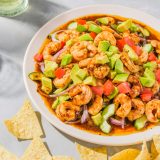My flight from Boston to Puerto Vallarta was delayed 24 hours, so when I finally touched down in the late afternoon, I was more than ready for food and drink. My guides, food writers Paola Briseño-González and Javier Cabral, took me to El Solar, a hole-in-the-wall café/bar on the touristy beachfront that, at first, felt more like spring break than culinary destination.
The food told a different story. The small dish of aguachile negro de camarón—a form of ceviche using shrimp—was arguably the best dish I had during my visit.
Though the shrimp may be served raw, in this version, they were parcooked, though just barely. The accompanying thin black sauce starts with charred bird chilies or pequín peppers, along with Worcestershire, soy sauce, lime juice and perhaps Maggi, a flavor enhancer available in most supermarkets, with cucumber, red onion and avocado as accompaniments. (Worcestershire and soy sauce make an appearance in other seafood dishes, such as pescado zarandeado, which I had up the coast in Nayarit. The use of soy sauce is likely influenced by Chinese immigrants.)
Unlike ceviche, here one gets spiciness as well as depth, a bracing but deeply flavored sauce that has no business being the perfect complement to seafood. Like mixing chilies with chocolate, it shouldn’t work, but it does.
A simple seafood salad is a common dish on the Pacific coast of Mexico, fresh with the sharp bite of lime, but aguachile negro offers a more compelling melding of spice, fermentation, fresh vegetables and briny shrimp—a dish that grabs your attention even when you’re sitting in a beach bar with a death grip on your first frozen margarita. All of a sudden, the world makes perfect sense.
There’s Worcestershire in My Ceviche!
Christopher Kimball

Get the Recipe
Mexican-Style Shrimp in Chili-Lime Sauce (Aguachile Negro)
A dark, deeply savory sauce accents this fiery, brightly acidic shrimp dish.
Photo: Connie Miller of CB Creatives; Styling: Monica Mariano







